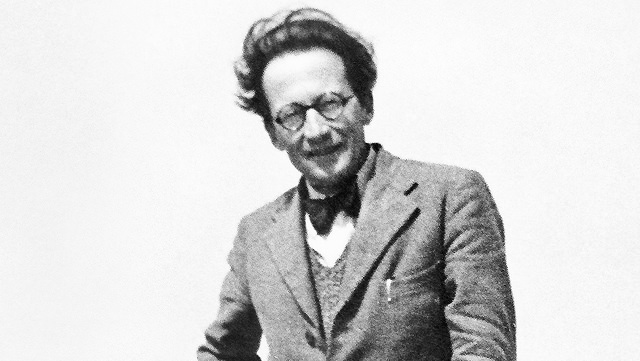Currently the facade of the Dublin Institute of Advanced Studies is decorated with a huge image of Erwin Schrödinger. This year is the 75th anniversary of the physicist’s lecture, given under the auspices of the institute, the famous ‘What is life?’
This exposition played an influential role in the development of molecular physics and the discovery of the mechanism of DNA by which life forms are encoded.
I passed his image with a wry smile, as it recalled an incident of the 1940s. The institute was a special project for de Valera, at whose invitation Schrödinger, a refugee in Ireland from persecution in his native Austria, became the first director. Its work led to Myles an Gopaleen (who disliked Dev) to observe that in its first years the institute had achieved little beyond ‘proving that there were two Patricks and no God’.
That remark was a nice example of the often smart alec comments of Brian O’Nolan on life in general.
The first reference was to T. F. O’Rahilly’s equally notorious 1942 lecture on the ‘Two Patrick’s’. Now this is a genuine problem, and one which has not been truly solved.
The medieval sources refer to Palladius, to an ‘Old Patrick’ and a ‘Young Patrick’ – leading some to conclude that ‘old Patrick’ was in fact Palladius (sent by the Pope) and ‘young Patrick’ was the Briton Patricius, son of Calpurnius. O’Rahilly was discussing a serious unresolved problem in Irish history. It was glib to say he ‘proved’ that there were two Patricks.
Deferring the matter of Schrödinger and God for a moment, I might recall an incident from 1986 when I was writing the first biography of Brian O’Nolan with my friend Dr Peter van de Kampe.
Myles’s comment greatly irritated the administration of the institute, or perhaps de Valera, and Myles was threatened with legal action. We wrote to Captain J. P. Duggan, the historian, then the secretary of the institute, about what records survived of this affair.
Duggan asked us to meet him. He explained that the institute would much prefer we made no reference to the matter which, a generation later, was a source of some embarrassment.
In the 1940s Myles was an irritant; by the time we wrote he was a recognised giant of Irish literature. To have threatened him with a civil action for damages reflected badly on an institution dedicated to the search for truth it seemed. Naturally enough we published the details – that is what authors do.
But to return to Schrödinger on God. As I say, the idea that he ‘proved there was no God’ is also a smart remark rather than an insight. In his lecture Schrödinger did not address the matter of God at all. But in the epilogue added to his text when it was published by Cambridge University Press in 1944 he discussed the question of determinism and free will.
Schrödinger’s mother had been a Lutheran, his father a Catholic. He called himself an atheist, yet he was deeply influenced by the Indian Upanishads. As regards denying God – whatever that may have meant to Myles na Gopaleen – he ends the epilogue with a discussion of the immortality of consciousness.
Neighbours
I suspect Myles had no real interest in the matter. Most of the information which he deploys to suggest a well educated man was derived largely from his ancient edition of the Encyclopaedia Britannica, consulted in the course of those Sunday afternoons, when, relatively sober for a few hours, he composed all three of his weekly articles for the Irish Times.
These days ‘Schrödinger’s Cat’ has passed into parlance as an illustration of the dilemmas of space and time in modern physics.
But to his neighbours out in Clontarf, it was ‘Schrödinger’s dog’ that bothered them. An odd beast, it had a settled inclination to steal items from clothes lines which the philosopher had then to return with a diffident apology.
Schrödinger may have been a protégé of de Valera, but the unusual arrangements of his private life caused those neighbours some discreet amusement. However, 1940s Ireland was in fact far more tolerant than we are often led to suppose these days.


 Peter Costello
Peter Costello Erwin Schrödinger
Erwin Schrödinger 